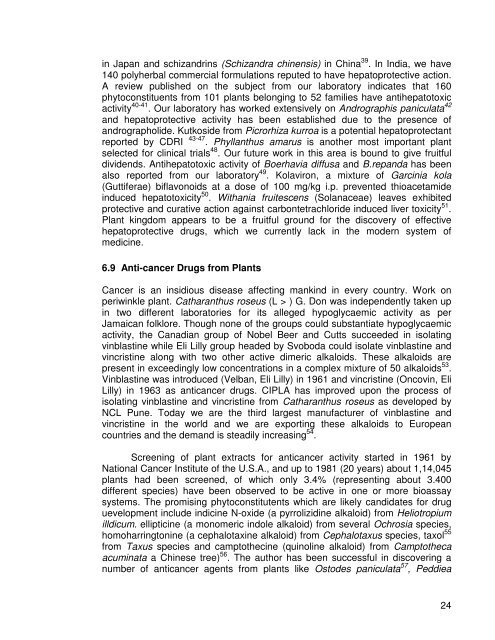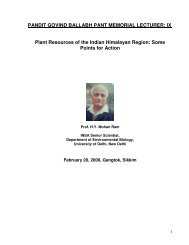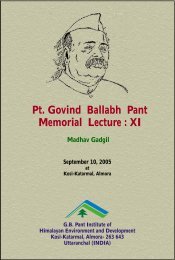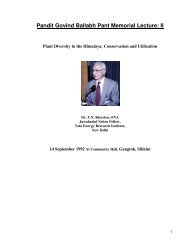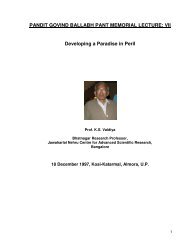Pt. Govind Ballabh Pant Memorial Lecture - XI Medicinal Plants for ...
Pt. Govind Ballabh Pant Memorial Lecture - XI Medicinal Plants for ...
Pt. Govind Ballabh Pant Memorial Lecture - XI Medicinal Plants for ...
- No tags were found...
You also want an ePaper? Increase the reach of your titles
YUMPU automatically turns print PDFs into web optimized ePapers that Google loves.
in Japan and schizandrins (Schizandra chinensis) in China 39 . In India, we have140 polyherbal commercial <strong>for</strong>mulations reputed to have hepatoprotective action.A review published on the subject from our laboratory indicates that 160phytoconstituents from 101 plants belonging to 52 families have antihepatotoxicactivity 40-41 . Our laboratory has worked extensively on Andrographis paniculata 42and hepatoprotective activity has been established due to the presence ofandrographolide. Kutkoside from Picrorhiza kurroa is a potential hepatoprotectantreported by CDRI 43-47 . Phyllanthus amarus is another most important plantselected <strong>for</strong> clinical trials 48 . Our future work in this area is bound to give fruitfuldividends. Antihepatotoxic activity of Boerhavia diffusa and B.repanda has beenalso reported from our laboratory 49 . Kolaviron, a mixture of Garcinia kola(Guttiferae) biflavonoids at a dose of 100 mg/kg i.p. prevented thioacetamideinduced hepatotoxicity 50 . Withania fruitescens (Solanaceae) leaves exhibitedprotective and curative action against carbontetrachloride induced liver toxicity 51 .Plant kingdom appears to be a fruitful ground <strong>for</strong> the discovery of effectivehepatoprotective drugs, which we currently lack in the modern system ofmedicine.6.9 Anti-cancer Drugs from <strong>Plants</strong>Cancer is an insidious disease affecting mankind in every country. Work onperiwinkle plant. Catharanthus roseus (L > ) G. Don was independently taken upin two different laboratories <strong>for</strong> its alleged hypoglycaemic activity as perJamaican folklore. Though none of the groups could substantiate hypoglycaemicactivity, the Canadian group of Nobel Beer and Cutts succeeded in isolatingvinblastine while Eli Lilly group headed by Svoboda could isolate vinblastine andvincristine along with two other active dimeric alkaloids. These alkaloids arepresent in exceedingly low concentrations in a complex mixture of 50 alkaloids 53 .Vinblastine was introduced (Velban, Eli Lilly) in 1961 and vincristine (Oncovin, EliLilly) in 1963 as anticancer drugs. CIPLA has improved upon the process ofisolating vinblastine and vincristine from Catharanthus roseus as developed byNCL Pune. Today we are the third largest manufacturer of vinblastine andvincristine in the world and we are exporting these alkaloids to Europeancountries and the demand is steadily increasing 54 .Screening of plant extracts <strong>for</strong> anticancer activity started in 1961 byNational Cancer Institute of the U.S.A., and up to 1981 (20 years) about 1,14,045plants had been screened, of which only 3.4% (representing about 3.400different species) have been observed to be active in one or more bioassaysystems. The promising phytoconstitutents which are likely candidates <strong>for</strong> druguevelopment include indicine N-oxide (a pyrrolizidine alkaloid) from Heliotropiumilldicum. ellipticine (a monomeric indole alkaloid) from several Ochrosia species,homoharringtonine (a cephalotaxine alkaloid) from Cephalotaxus species, taxol 55from Taxus species and camptothecine (quinoline alkaloid) from Camptothecaacuminata a Chinese tree) 56 . The author has been successful in discovering anumber of anticancer agents from plants like Ostodes paniculata 57 , Peddiea24


